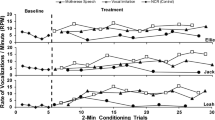Abstract
Children with autism and related disabilities frequently fail to develop echoic repertoires. Among the ways in which treatment approaches vary is the extent to which automatic reinforcement is utilized. The present experiment was designed to test the efficacy of a procedure that incorporates automatic reinforcement and socially mediated reinforcement in the development of an echoic repertoire. The implementation of this treatment package resulted in an increase in the vocal play and echoic behavior for two participants, each of whom had very limited verbal repertoires. The study was conducted as a multiple probe across sounds design. Vocal play for Participant 1 increased from baseline rates as low as.2 per min to 4.5 per min during treatment, and her percent correct echoic behavior increased from 0% to at least 90% on both sounds. Participant 2 showed rapid gains in echoic control on one sound before requiring dismissal from the study. Interobserver agreement on the occurrence of target vocals equaled 100%. The results of this study have implications for which procedures to use in the establishment of echoic, echoic mand, and mand repertoires.
Similar content being viewed by others
References
Bijou, S. W., & Baer, D. M. (1965). Child development II: Universal stage of infancy. Englewood Cliffs. NJ: Prentice-Hall.
Bijou, S. W., & Ghezzi, P. M. (1999). The behavior interference theory of autistic behavior in young children. In M. Ghezzi, L. Williams, & J. Carr, (Eds.), Autism: behavior analytic perspectives (pp. 33–43). Reno, NV: Context Press.
Bondy, A. S., & Frost, L. A. (1993). Mands across the water: A report on the application of the picture-exchange communication system in Peru. The Behavior Analyst, 16, 123–128.
Drash, P. W., High, R. L., & Tudor, R. M. (1999). Using mand training to establish an echoic repertoire in young children with autism. The Analysis of Verbal Behavior, 16, 29–44.
Englemann, S., & Carnine, D. (1982). Theory of instruction: principles and applications. New York: Irvington.
Hall, G., & Sundberg, M. L. (1987). Teaching mands by manipulating conditioned establishing operations. The Analysis of Verbal Behavior, 5, 41–53.
Koegel, R. L., O’Dell, M. C., & Koegell, L. K. (1987). A natural language teaching paradigm for nonverbal autistic children. Journal of Autism and Developmental Disorders, 17, 187–200.
Lord, C. (1993). Early social development in autism. In E. Schopler, M. E., Van Bourgondien, & M. M. Briston (Eds.), Preschool issues in autism (pp. 61–94). New York: Plenum Press.
McDonald, E. T., & Schultz, A. R. (1973). Communication boards for cerebral palsied children. Journal of Speech and Hearing Disabilities, 38, 73–88.
Michael, J. L. (1993). Concepts and principles of behavior analysis. Kalamazoo, MI: Association for Behavior Analysis.
Miguel, C. F. (2001). The effects of automatic reinforcement on vocal behavior of children diagnosed with autism. Unpublished manuscript, Western Michigan University, Kalamazoo, MI.
Ornitz, E. M., & Ritvo, E. R. (1986). Perceptual inconsistency in early infantile autism. Archives of General Psychiatry, 18, 76–98.
Ross, D., & Greer, R. D. (1998, May). Behavioral momentum across response classes to induce echoics and mands with children with autism who had no prior vocal-verbal repertoires. Douglas Greer (chair), Experimental Analyses in Applied Settings: New Controlling Variables for the Behavior of YoungChildren with Autism or Language Delays. Symposium at 24th annual convention of the Association for Behavior Analysis, Orlando, FL.
Skinner, B. F. (1957). Verbal Behavior. New York: Appleton-Century Crofts.
Smith, R., Michael, J., & Sundberg, M. L. (1996). Automatic reinforcement and automatic punishment in infant vocal behavior. The Analysis of Verbal Behavior, 13, 39–48.
Sundberg, C. T., & Sundberg, M. L. (1990). Comparing topography based verbal behavior with stimulus selection-based verbal behavior. The Analysis of Verbal Behavior, 8, 31–41.
Sundberg, M. L. (1993). The application of establishing operations. The Behavior Analyst, 16, 211–214.
Sundberg, M. L., Michael, J., Partington, J. W., & Sundberg, C. A. (1996). The role of automatic reinforcement in early language acquisition. The Analysis of Verbal Behavior, 13, 21–37.
Sundberg, M. L., & Partington, J. W. (1998). Teaching language to children with autism or other developmental disabilities. Pleasant Hill, CA: Behavior Analysts, Inc.
Thompson, R. (2001, May). Utilization of a sterile environment to facilitate the acquisition of mands in children with autism. In John Esch (chair), Teaching Verbal Behavior to Children with Autism. Symposium conducted at the 27th annual convention of the Association for Behavior Analysis, New Orleans, LA.
Vaughan, M. E., & Michael, J. L. (1982). Automatic reinforcement: An important but ignored concept. Behaviorism 10, 217–227.
Wing, K. G. (1947). The role of the optic cortex of the dog in the retention of learned responses: Conditioning with light and food. American Journal of Psychology, 60, 30–67.
Wraikat, R., Sundberg, C. T., & Michael, J. (1991). Topography-based and selectionbased verbal behavior: A further comparison. The Analysis of Verbal Behavior, 9, 1–18.
Yoon, S. (1998). Effects of an adult’s vocal sound paired with a reinforcing event on the subsequent acquisition of mand functions. UMI Dissertation Services (UMI), Number TX 4-872-654). A Bell & Howell Company. Ann Arbor, MI.
Yoon, S., & Bennett, G. M. (2000). Effects of a stimulus-stimulus pairing procedure on conditioning vocal sounds as reinforcers. The Analysis of Verbal Behavior, 17, 75–88.
Author information
Authors and Affiliations
Corresponding author
Rights and permissions
About this article
Cite this article
Ward, S.J., Osnes, P.J. & Partington, J.W. The Effects of a Delay of Noncontingent Reinforcement during a Pairing Procedure in the Development of Stimulus Control of Automatically Reinforced Vocalizations. Analysis Verbal Behav 23, 103–111 (2007). https://doi.org/10.1007/BF03393050
Published:
Issue Date:
DOI: https://doi.org/10.1007/BF03393050




